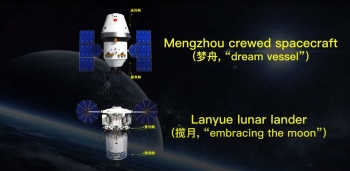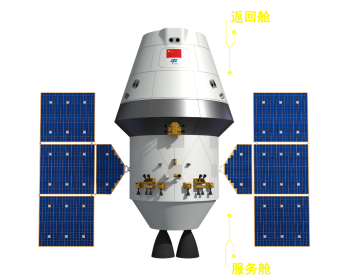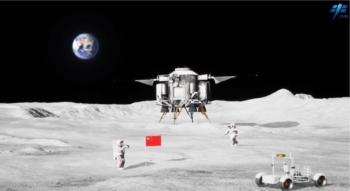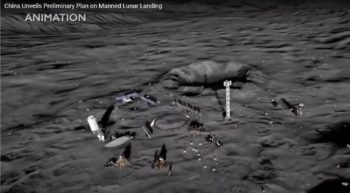
Image credit: China National Space Administration (CNSA)/China Central Television (CCTV)/SciNews.ro/Inside Outer Space screengrab
China has officially named the vehicles that will support that country’s human exploration of the Moon.
A three seater spacecraft is called “Mengzhou” (Dream Vessel) and the lunar lander is named “Lanyue” (Embracing the Moon), in English translation.
Lanyue first appeared in a poem written by the late Chairman Mao Zedong in 1965, noted the China Manned Space Agency (CMSA) in announced the names, underscoring aspiration and confidence in exploration of the universe and the Moon.
Cultural connotations
The names of the new vehicles were solicited from the public in an event launched last August. The two names selected came from nearly 2,000 submissions.
“The names Mengzhou and Lanyue of the two new space vehicles carry distinct characteristics of China and the times, and have rich cultural connotations,” said Ji Qiming, director assistant of the China Manned Space Engineering Office (CMSEO).
These spacecraft, along with development of the Long March-10 carrier rocket, “will carry forward Chinese people’s dream of exploring the vast universe and reaching the moon,” Ji told China Central Television (CCTV).
Successive launches
Previously, China space officials have sketched out preliminary plans to land a crew on the Moon by 2030.
As released by China Manned Space Agency that plan makes use of two successive Long March-10 carrier rocket launches, hurling the Lanyue lander and Mengzhou spacecraft separately from the Earth to a trans-lunar injection orbit.
“The two spacecrafts conduct rendezvous and docking in lunar orbit. Then astronauts will enter the lander and the lander will send them to the lunar surface where they’ll carry out scientific investigation and sample collection according to plan,” Ji said.
Back to Earth
After completing the set tasks on the lunar surface, the moonwalkers would then take the Lanyue lander back into to lunar orbit, with the two spacecraft joined again.
“Astronauts are going to transfer the lunar samples they’ve collected to the Mengzhou spacecraft, and the spacecraft will return to the Earth via trans-lunar injection orbit,” said Ji.
“For now, the development of primary spacecrafts such as the carrier rocket Long March-10, Mengzhou manned spacecraft, Lanyue lander and spacesuits are finished,” added Ji.
The overall technical proposal for launching site and landing site is also completed, Ji told CCTV.
The lunar science payload, a human-controlled lunar rover, and lunar activity support system have been under formulation, Ji said. “The setting up of various newly-built facilities and equipment for test launch in Wenchang Spacecraft Launch Site will start later.”

China’s plans for human crews on the Moon are being shaped.
Image credit: CCTV/Inside Outer Space screengrab
Step-by-step
Ji indicated that China’s humans on the Moon endeavor will be implemented “step-by-step,” including uncrewed flight test to piloted lunar flight.
According to the China Manned Space Agency plan, the Lanyue lunar lander will consist of two parts: a lunar module and a propulsion module, with a weight of nearly 26 tons. It is capable of carrying two astronauts and a lunar rover weighing 440 pounds (200 kilograms) to the lunar surface.
China Global Television Network (CGTN) reports that there will be two Mengzhou models. One will be used to transport astronauts to the Moon and the other will replace the current Shenzhou spaceship now in use that transports crew members between Earth and China’s space station that has been orbiting around the Earth for nearly three years.
Three-person crew
According to CGTN, the crewed Moon lander has a lightweight design to improve structural efficiency and has a power redundancy function.
The Mengzhou spacecraft will consist of two major components: a reentry module that will house astronauts and serve as the control center during spaceflight, and a service module containing power and propulsion systems.
According to the plan, the Mengzhou will be nearly 30 feet (9 meters) in length, 15 feet (4.5 meters) in diameter, weigh 22 metric tons, and would be capable of housing three astronauts.
Moon booster
Currently, the research and development of the Mengzhou, the Lanyue, and the Long March-10 heavy-lift carrier rocket are reportedly progressing well.
The Long March-10 carrier rocket has two configuration designs: a standard combination of first, second, and third stage cores, escape tower, and fairing, with boosters or without boosters. The variant with boosters will be used to send the lunar lander and the spacecraft into trans-lunar orbit.
Weighing 2,187 tons, the over 300 foot (92 meters)-tall rocket variant is more powerful, with 2,678 tons at liftoff, a significant increase compared to the country’s current most powerful carrier rocket, the Long March-5, with a liftoff thrust of over 1,000 tons.
For a video showcasing China’s humans to the Moon enterprise, go to:






No comments:
Post a Comment